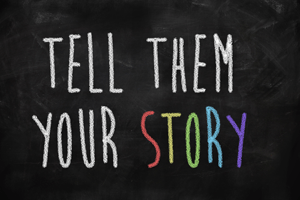How to Unleash the Power of Storytelling in Marketing
There is a lot of noise out there about storytelling in marketing; all kinds of advice, articles, blog posts, as well as a lot of hype. However, there is not a lot of clarity, communications expert Rob Biesenbach said.
Biesenback sought to clarify what a story is and how best to connect with customers through storytelling.

“If you can be a good storyteller there’s no limit to what you can do,” he said. “Stories break down walls, build trust and influence people to act.”
He identified six ingredients that give stories power:
- Stories tap into emotion (people do not respond to facts and logic)
- They put a face on an issue (nobody cares about process; they care about people)
- Stories connect us
- They humanize us (people want to see your personal side)
- Stories raise the stakes (appeal to universal, shared values)
- Stores are about “show/don’t tell.” It’s one of the best things stories do. Don’t make claims. Tell stories.
“Emotion trumps logic when it comes to storytelling,” Biesenback said. “If you want to learn to tell great stories, what better model than show businesses.”
Americans spend $10 billion a year going to movies and 35 hours a week of TV. Add to that video games are a $15 billion industry.
“Our brains are hardwired for stories and they have a unique effect on our brains,” he says. “One study showed that when we hear a story it triggers the same area of the brain as when we experience an event. There is little distinction between story and experience. Stories sweep us up on a number of levels, our heart rates go up and we often put ourselves in the story or relate to the protagonist.”
He said that 63% of people remember stories, while just 5% remember statistics.
“Stories are the hook,” he says. “Stories are the thing people are going to remember.”
Every story should have a beginning, middle and end: The three-legged story stool:
1. Character “It’s about a character in pursuit of a goal in the face of some challenge,” says. “It’s about how the character overcomes the challenge, which provides conflict and drama and that provides the interest.”
He used the example of I love Lucy, and the show’s zany redhead, Lucy, living in NY. Her goal was to get into show businesses but her husband was the obstacle, he wouldn’t let her and the drama played out over and over in the series.
“As homework, look for this structure at work. You will find it at the base of every good story,” he said. “When we’re telling stories in marketing we want to have these elements: who’s my audience, what are the goals of my customer and then find a character to overcome those challenges. The ideal character is one your audience can relate to—a public figure or a fellow employee.
2. Connect with emotion Emotion is the literal and figurative heart of storytelling. Use the strategic application of emotion for a real business purpose. (Read how Great Wolf Lodge uses emotion in storytelling in marketing.)
“Ask yourself, ‘what does the audience want to know and do.’ The key to unlocking ‘do’ is to make them feel something using the power of emotion,” Biesenback said. “Emotion triggers decision-making. You want to trigger an emotional response in whomever you’re communicating with. Don’t talk about what you do, but why you do it. Don’t be afraid to get personal; to tell stories about who you are and where you came from and how that relates to where you are today.”
Storytelling in marketing is about making choices, creating stories we can relate to and standing up to lawyers and others who want to water down your story.
3. Less is more “Shorter is better, not just less time, less stuff. The key is to use essential details not unnecessary details,” he said.
“Take risks, express yourself freely with passion,” Biesenback said. “That is the key to creating long-term connections with your customers, help build your reputation and sell your products and services.”
This article was originally published in August 2016 and has been regularly updated.




























